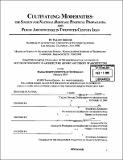Cultivat(ing) modernities : the Society for National Heritage, political propaganda and public architecture in twentieth-century Iran
Author(s)
Grigor, Talinn, 1972-
DownloadFull printable version (89.65Mb)
Other Contributors
Massachusetts Institute of Technology. Dept. of Architecture.
Advisor
Stanford Anderson and Arindam Dutta.
Terms of use
Metadata
Show full item recordAbstract
Beginning in 1922, under the auspices of the Pahlavi dynasty of Iran, the tombs of selected historical figures were systematically destroyed to make way for modern mausoleums erected as metaphors for an "Aryan" nation in its process of modem revival. Initiated during the reign of Reza Shah who ruled the country with an iron fist between 1921 and 1941, most of the projects were implemented under his son, Mohammad Reza Shah, between 1941 and the Iranian Revolution of 1979. Since the monuments were ideologically inscribed commemorations of the leading modernists and reformists of the 1920s, their impact permeated the definition and function of high culture in Iran's 20th-century sociopolitical history. The dissertation offers a critical analysis of the political underpinnings, pedagogical aims, racial schemas, and aesthetic ends of propaganda architecture as they were conceived and constructed under the aegis of the Society for National Heritage. An in-depth study of the institutional history of the SNH, which included the construction of numerous mausoleums--particularly those belonging to Ferdawsi, Hafez, Ibn Sina, Omar Khayyam, and Arthur Pope, the supervision of over sixty preservation projects, and the creation of an archeological museum as well as a national library, the dissertation demonstrates that in the 20t century, the project of Iran' s "cultural heritage" was not just about a series of public monuments, well-choreographed museums, (in)accurate indexes of historical landmarks, or art exhibitions and congresses. Modern Iran's relationship to its cultural heritage was equated to Iran's equal and rightful place in the network of modern nations; its safest and fastest corridor to a progressive, and at times utopian, modernity; and its essential ideological (cont.) justification for the political, and often despotic, reforms aimed at territorial integrity and national homogeneity. Iran's cultural heritage, it is argued, was modem Iran's political raison d'e'tre.
Description
Thesis (Ph. D.)--Massachusetts Institute of Technology, Dept. of Architecture, 2005. Includes bibliographical references (p. 615-632).
Date issued
2005Department
Massachusetts Institute of Technology. Department of ArchitecturePublisher
Massachusetts Institute of Technology
Keywords
Architecture.